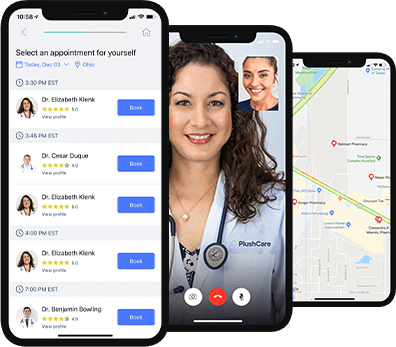STD Symptoms in Women: Recognize the Signs
What causes STDs and how do I know if I have an STD? Here, we'll be taking a look at some of the most common STDs in women and the symptoms you need to look out for.
Sexually transmitted diseases are infections, usually bacterial but sometimes caused by fungi or viruses, that are specifically passed from one person to another through any sort of sexual contact.
While many people assume this only refers to vaginal or anal intercourse, sexual contact can include oral sex, kissing, and the use of sex toys.
The most difficult thing about STDs is that they don’t always exhibit symptoms and many women may not even know they have an STD. To help you out and ensure your good health, let’s take a look at some common STDs and their associated symptoms, in women.

1
Book on our free mobile app or website.
Our doctors operate in all 50 states and same day appointments are available every 15 minutes.
2
See a doctor, get treatment and a prescription at your local pharmacy.
3
Use your health insurance just like you normally would to see your doctor.
Gonorrhea
Gonorrhea is one of the oldest known STDs, generally infecting more women than men. An estimated one million women are currently infected with gonorrhea.
It can only live outside the human body for a few minutes, and it can’t survive on the surface skin of your hands, legs, or arms. Gonorrhea requires moist, warm surfaces, including the urethra, the vagina, the rectum, and even the back of the throat. In the vagina, gonorrhea bacteria are most likely to be found in the cervix.
Symptoms for gonorrhea vary, and a majority of women with the infection don’t show symptoms. Some symptoms that could point to gonorrhea include:
Abnormally frequent urination | Burning when you pee |
Itching or burning in the vagina | Redness and swelling in the genital area |
Chlamydia
Chlamydia is one of the most common sexually transmitted diseases among women. Each year, over 4 million women are affected by chlamydia. Similar to gonorrhea, chlamydia can survive in the rectum or throat as well as the vagina.
Can a woman have an STD with no symptoms? Most women who have chlamydia exhibit no symptoms.
Cervicitis, which is the infection of the uterine cervix, is the most common result of chlamydia, but about half the women with cervicitis show no symptoms. The other half of women experience abdominal pain and vaginal discharge.
Chlamydia is most destructive to a woman’s fallopian tubes, causing severe fertility issues and tubal pregnancy. Some women with chlamydia develop pelvic inflammatory disease, which is an infection of a woman’s reproductive organs.
Read: Get Chlamydia Treatment Online
Syphilis
Syphilis is an STD caused by a spirochete, a spiral-shaped, worm-like bacterial organism that burrows into moist, mucus-covered tissues, like those in the genitals or around the lining of the mouth.
Syphilis occurs in three stages.
The first stage:
The spirochete forms a painless ulcer called a chancre (pronounced similar to “canker”). This can develop 10 to 90 days after initial infection.
While the ulcer doesn’t pose many problems to your health, syphilis is highly contagious when the ulcer is present as it is essentially filled with spirochetes. So much as kissing can actually spread the disease. In most women, this first stage will resolve on its own, though the disease can come back months later.
The second stage:
Syphilis can affect various organs of your body, leading to a wide range of potential symptoms, but the most common symptom is a skin rash on your palms or the bottoms of your feet. Other symptoms of the STD in women include:
Fever | Sore throat |
Headaches | Hair loss |
Lesions around your genitals | Swollen lymph glands |
The third stage:
After secondary syphilis, you may not exhibit any more symptoms but still carry the disease. This is called the latent stage, which can last more than 20 years and potentially lead to the third stage. At this point, syphilis isn’t contagious, but it can lead to more serious issues, including:
Large nodules, called gummas, developing in organs of the body | A brain infection, which can cause strokes, meningitis, and general mental and sensory problems |
Heart problems caused by abnormal bulging of your aorta | Sores in the mouth, vagina, or anus, or possible other body parts |
Eye problems and deteriorating sight | Ear problems leading to deafness |

1
Book on our free mobile app or website.
Our doctors operate in all 50 states and same day appointments are available every 15 minutes.
2
See a doctor, get treatment and a prescription at your local pharmacy.
3
Use your health insurance just like you normally would to see your doctor.
Human Papillomavirus (HPV)
There are over 40 known types of HPV, which are responsible for causing genital warts. It’s considered the most common sexually transmitted infection in the country. While warts might not seem like a big deal, HPV can cause cervical and anogenital cancers in women. In men, HPV infections have been linked to penile and anal cancers.
Thankfully, most women with HPV infection don’t develop cancer, warts, or any other symptoms.
Detecting HPV often comes down to identifying the DNA of the virus within your system through advanced testing.
Genital Herpes
Caused by the herpes simplex virus, genital herpes enters your system via microscopic tears in your skin and is spread via contact with the mouth or vagina of an infected individual. Once the herpes simplex virus enters your body, it travels to your nerve roots near the spinal cord.
The virus comes in two forms. Herpes simplex virus-1 is characterized by blisters around the mouth, while herpes simplex virus-2 is associated with lesions around the anus and sores on the genitals.
Many doctors believe that many adults carry the herpes virus, but the high infection rate is perpetuated by the fact that most people infected by herpes show minimal or no symptoms at all.
For example, some women with herpes have atypical outbreaks that result in only mild itching and discomfort.
Herpes outbreaks usually happen within the first couple weeks of infection, manifesting as itching, tingling, and redness in the skin, eventually leading to blisters and ulcers around the genitals, buttocks, thighs, and rectum. Until the ulcer is fully healed, the infection is highly contagious.
Other symptoms of genital herpes include:
Pain during urination from urine making contact with sores | Flu-like symptoms (fever, fatigue, swollen lymph nodes) |
Headaches | Backaches |
Read: How to Get Rid of Cold Sores Fast
Hepatitis B (HBV)
Most people don’t think of hepatitis as a sexually transmitted infection, but hepatitis B is most commonly spread through sexual contact. Complications from hepatitis B account for an estimated 2 million deaths in the United States every year.
The first stage of HBV lasts a few weeks and usually clears on its own. People who recover from this initial stage actually develop an immunity to it, but another fraction of people develop long-lasting, chronic problems and can potentially infect others.
The disease is most noted for causing damage to the liver.
Symptoms of hepatitis B include:
Jaundice, or yellowing of the skin and eyes | Pain in the upper abdomen |
Nausea | Fever |
Generally feeling ill | Liver failure, cirrhosis, and liver cancer. |
Chancroid
Chancroid appears most commonly in genital areas exposed during sex. In women, it’s most common in the labia, clitoris, and entrance to the vagina.
It starts out as a small bump on the skin several days after sex.
As the cells within this bump die, the bump turns into a painful open sore (known as an ulcer). The ulcer can then bleed or produce a fluid that can be highly contagious and spread through vaginal, oral, and anal intercourse. The infection can also spread to others via skin-to-skin contact.
In about one third of cases, the sores are often associated with tenderness in the groin and swelling of the lymph nodes.
Women in particular can suffer from pain or a burning sensation when peeing or during bowel movements.
HIV and AIDS
Human Immunodeficiency Virus attacks your immune system, making your body more vulnerable to infections, illnesses, and certain cancers. The virus is primarily transmitted via sex and the sharing of needles, though a pregnant mother can potentially spread the virus to her newborn.
People infected by the virus will test positive for the virus within 12 weeks after exposure.
There generally aren’t any specific symptoms that point to HIV, but many people exhibit some sort of unspecific illness a few weeks after exposure. This illness can be characterized by:
Fever | Diarrhea |
Sore throat | Swollen, painful lymph nodes |
Vomiting | Pain in the muscles and joints |
On average, it takes a whole 10 years for the HIV infection to develop symptoms related to a weakened immune system. Some of the more serious complications include:
Weight loss | Dementia (a state of mental deterioration) |
Certain forms of cancer | Death |
In its final and most serious stage, HIV leads to acquired immunodeficiency syndrome, known better as AIDS. This can lead to a wide range of disparate symptoms, from general fatigue to sores to pneumonia.

1
Book on our free mobile app or website.
Our doctors operate in all 50 states and same day appointments are available every 15 minutes.
2
See a doctor, get treatment and a prescription at your local pharmacy.
3
Use your health insurance just like you normally would to see your doctor.
Read: 95% of Patients Pay Nothing for PrEP with PlushCare
Steps to Prevent Sexually Transmitted Diseases
The only real way to completely prevent sexually transmitted infections is to practice abstinence, which has various definitions from person to person, but generally means not having any form of sex play at all.
However, that isn’t always feasible, and there’s no reason you can’t have a fun, enjoyable sex life while still staying healthy and reducing your risk of STIs along the way.
The foundation for preventing sexually transmitted diseases is to practice safe sex. The condom is the best tool for safe sex and often the frontline for preventing many STDs.
Learn how to use condoms properly and use a condom whenever you have sex. While condoms can generally last a long time, they do have expiration dates. Most importantly, the condom should be worn the entire time you are having sex.
Some other safe sex tips to prevent STDs in women:
Use a dental dam when performing oral sex and wash your genital area after sex. | Wear a latex glove if you perform any form of manual penetration |
If you do use lube, make sure to only use water-based lubes to reduce the chance of irritation | Try to pee soon after sex to flush out any bacteria that may have entered your vagina |
Along with safe sex practices, make sure you get tested regularly. This is especially important considering some sexually transmitted infections don’t show symptoms.
Some testing guidelines for specific sexually transmitted infections:
For gonorrhea and chlamydia, get tested annually if you’re sexually active and under the age of 25 or if you’re having sex with a new partner or multiple partners. | You should be tested at least once for HIV if you’re between 15 and 65. Annual HIV testing is recommended for those who have a high risk for infection. | Most doctors will offer women an HPV test if their Pap tests showed abnormal results. Women over the age of 30 may be offered an HPV test every five years. |
Most importantly, make sure you maintain open communication with any sexual partners.
Discuss what you enjoy during sex and what you don’t. Talk about any history you both may have with STIs to not only stay safe, but also to accommodate and keep the experience enjoyable and positive for all parties involved.
How can you check for STDs at home? If you experience any symptoms of an STD, call or book an appointment with PlushCare to set up a video appointment with a top U.S. doctor today.
Read more of our STD series:
Sources:
PlushCare is dedicated to providing you with accurate and trustworthy health information.
Mayo Clinic. Gonorrhea. Accessed October 28, 2019 at https://www.mayoclinic.org/diseases-conditions/gonorrhea/symptoms-causes/syc-20351774
E Medicine Health. Syphilis in Women. Accessed October 28, 2019 at https://www.emedicinehealth.com/syphilis_in_women/article_em.htm#syphilis_symptoms_in_women
Centers for Disease Control and Prevention. How You Can Prevent Sexually Transmitted Diseases. Accessed October 28, 2019 at https://www.cdc.gov/std/prevention/default.htm



